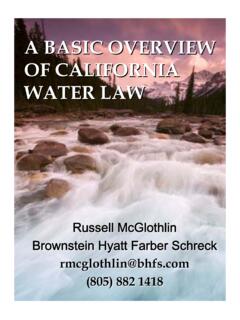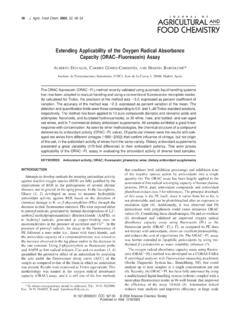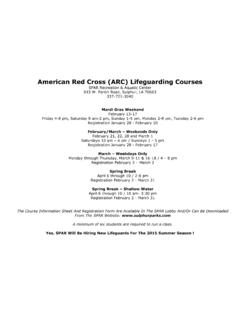Transcription of LIFE GUARD TR AINING WITH TITLE 22 FIRST AID
1 Lifeguards What are the requirements to become a lifeguard? Be at least 15 years of age by the last day of the course attended Attend all training sessions Pass a written test with a score of at least 80% Successfully complete a pre-course screening session which includes the following Swim 500 yards continuously, using these strokes: 200 yards of front crawl using rhythmic breathing and a stabilizing propellant kick 100 yards breaststroke 200 yards of either front crawl using rhythmic breathing, or breaststroke or a combination of both Swim 20 yards (front crawl or breast stroke), surface dive to a depth of 7-10 feet, retrieve a 10-pound object, and return with it to the surface, and swim back 20 yards holding it with both hands with your face out of the water and swim back 20 yards Perform all required skills with 100% accuracy What certifications do I get from basic Red cross Lifeguard Training?
2 Become an aquatic professional, learn professional lifesaving techniques, and gain leadership skills. This course will cover the skills needed to certify you to be a lifeguard. The class will certify for: lifeguarding Certification (good for 3 years) CPR for the Professional Rescuer Certification (good for 1 year) FIRST Aid Certification (good for 3 years) Lifeguard training (ages 15 adult) This 35 hour class is designed to teach the skills necessary to become a certified lifeguard for swimming pools. Students will receive instruction in CPR for the Professional Rescuer, FIRST Aid Basics, and Water Rescue techniques. Participants must be able to swim 300 yards continuously, tread water, and retrieve a 10 lb. object from 7 8 feet depth. This is a fun and fast paced class. Attendance at all sessions is mandatory. american Red cross certification is given at successful completion of the course.
3 Books and pocket mask are included in the course fee. Lifeguard recertification (ages 15 adult) Recommended for those previously trained in Red cross Lifeguard Training/ FIRST Aid and CPR for the Professional Rescuer who wish to become recertified in any or all three Red cross certifications. Participants must be prepared and confident in their ability to efficiently perform skills and pass written tests upon arrival. LIFE GUARD TR AINING with TITLE 22 FIRST AID This course will certify students in Lifeguard Training, FIRST Aid, and CPR for the Professional Rescuer. In addition to the CPR and FIRST aid skills, this class will cover water rescues, professionalism, prevention, and many other topics to prepare the participants for a job as a lifeguard. Course materials are included in registration fee and MUST be picked up at the Parks and Recreation office prior to FIRST class meeting.
4 Must be at least 15 years old and pass the pre-course swimming test to participate. Also covered will be the additional FIRST aid skills required by the State of California to meet the TITLE 22 requirements, by teaching the FIRST Aid for Public Safety Personnel class at the conclusion of each Lifeguard Training (LGT) class. After successful completion of the two classes, participants will have all the required certifications to apply for a job as a lifeguard. LifegTo fucamwatesafettechrequ ESS123 QUAEFF SombendwateprepWillinavail The Certcertif GUARD Role urther the mp s waterfroerfront facilitity and accidniques, admuired. LifeguaENTIAL TA1. Supervisactivities each 25 Provi Utiliz Undecond Evaluabilitiwater2. Assist wa Ensu Act a Assis3. Assist in area. Cond Clean ChecreplaALIFICATIOECTIVELY Ame physical rding, stoopinerfront equippare, and comngness to livlable.
5 Operacamp aquatificate, YMCficate. Current c Prior exp Training Desire an Knowledand Respoission of thent activities. ies and equident preventiminister FIRST aards work wSKS e and guardto help prevcampers in tde rescues e FIRST aid anerstand and itions affectiuate aquaticies to shallowr. aterfront instre campers as reference st in the delivthe manageduct daily chn waterfront ck out a FIRST cing used mN STANDAAND SAFEL requirementsng, and stretpment and wmmunicate ave in a campate with dailytics supervisCA Swim Lifecertification iperience at aand experiend ability to ge and prioronsibility e 4-H camp bAssist in thepment. Undion programaid as necesith the Campd all waterfrovent and to mthe water. as needed. nd CPR and implement ang the wates abilities ofw swimmingtructional staand staff folin waterfronvery and supement and ceck of area area daily kaid kit from materials at thRDS WHICHLY s of a lifeguatching.
6 Requaterfront actappropriate p setting andy exposure tsor shall be aesaving Certin FIRST aid ana waterfront ence in waterwork with chr use of a kaby providinge managemeer supervisios for a swimssary; and pp Director anont inju other emergappropriate rrfront. fcampers ang areas or toaff in prograllow safety pnt of aare of the phand equipmkeeping it frethe Nurse's he end of thH AN INDIVard position cuires eye-hativities. Reqcamper activd work irreguto the sun aat least 18 ytificate, Amend CPR andsimilar to therfront activitihildren outdoayak as used supervisionent of the phon, Lifeguarmming area, eerform othernd/or 4-H sta. Provide suries; these sgency manaresponse to nd staff and the use of pm areas sucprocedures wall water acthysical facilitent for safetee of hazardscabin beforee day. IDUAL MUScould be endand coordinaquires normavities/prograular hours tond heat andears of age erican Lifegu Open-Watee camp.
7 Ies that are ooors in the wd for water ren and ensurinhysical operards control aemploy lifesr related dutaff and otherveillance dushall be provagement servchanges in as appropriapersonal flotch as swimmwhile in theirtivities and sties and equty, cleanliness and debrise all events ST MEET INdurance, incation and maal range of hams and the o enable the varying watand possesuard Associaer Rescue anoffered at thwater. escues. ng a safe enation of the application ofsaving ties as r camp staffuring aquaticvided at a ravices as neewater condiate, restrict station deviceming and boar program acspecial evenuipment in thss, and goods. and to returN ORDER TOcluding proloanual dexterearing and eability to liftdelivery of pter conditionss an Americation Certificand Lifeguardhe camp. nvironment af f. c atio of one lifeded. tions or weaswimmers wes when neaating ctivity.
8 Ts at the wathe waterfrond repair. rn it after resO PERFORM onged standrity to manipeyesight to rt up to 50 lbsprogram at tns. can Red Croate, or an eqding. at the feguard for ather with limited ar or in the terfront. t program stocking or M THE JOB ing, ulate record, s. he facility oss Lifeguardquivalent d 4-H YDP Policy Requires at least one certified lifeguard be present at any activity that involves swimming. In addition, it is recommended that a ratio of one supervising adult for every five 4-H members be used throughout the swimming activity. If a certified lifeguard is not provided at the swimming activity location, then it is the event organizer s responsibility to arrange the services of a certified lifeguard for the duration of the swimming activity. The certified lifeguard may be an adult volunteer or teen 4-H member that has completed the requirements of a training program sanctioned by the american Red cross or american Lifeguard Association.
9 Your attentiveness and care may be the difference between happiness and disaster at the lake. Waterfront Rules: No one is to be on the beach or in the water unless a lifeguard is present. Report any injury immediately to the lifeguard on duty. 1. Swimming is allowed only within the predetermined swimming area. 2. No throwing of sand at any time. 3. Kayaks are for adults and JC's unless otherwise stated by a lifeguard. 4. A maximum of 3 campers per canoe. 5. All canoes and kayaks must remain in designated area at all times and returned to the "waterfront camp" at scheduled time. 6. Campers are only allowed to return back to Camp if 2 Adult Leaders or 2 JC's accompany them (avoid small groups). 7. Leave beach clean and litter free. Be considerate. 4-H Water Safety Guidelines I. INTRODUCTION The University of California 4-H Youth Development Program (YDP) organizes and coordinates a variety of programs, projects, and events that involve about 20,000 adult volunteers and more than 100,000 youth aged five through 19 years of age.
10 Many of these programs, projects, and events incorporate activities that take place on, in, or near water. Information given in these guidelines has been developed for use by 4-H staff and volunteers and is intended to provide initial guidance for implementing practices and procedures to reduce the risk of sustaining water-related injuries or illnesses while participating in 4-H sponsored programs, projects, and events. The Agriculture & Natural Resources (ANR) Environmental Health & Safety (EH&S) Office exists to support all ANR programs, including 4-H YDP, in conducting their activities in a safe, healthy, and environmentally responsible manner. ANR EH&S staff are available to assist 4-H YDP staff and volunteers to interpret the material in these guidelines and to develop specific health and safety information, assess potential hazards, and conduct training.



















